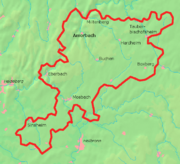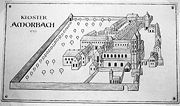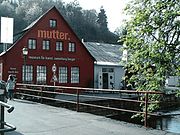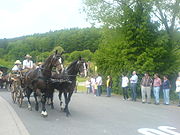| Main | Births etc |
|---|
| Amorbach | |
|---|---|
| Country | Germany |
| State | Bavaria |
| Admin. region | Unterfranken |
| District | Miltenberg District |
| Founded | |
| First mentioned | |
| Government | |
| • Mayor | Peter Schmitt (CSU) |
| Area | |
| • Total | 50.92 km2 (19.66 sq mi) |
| Elevation | 165 m (541 ft) |
| Population (2010-12-31)[1] | |
| • Total | 3,904 |
| • Density | 77/km2 (200/sq mi) |
| Time zone | CET/CEST (UTC+1/+2) |
| Postal codes | 63916 |
| Dialling codes | 09373 |
| Vehicle registration | MIL |
| Website | amorbach.de |
Amorbach is a town in the Miltenberg District in the Regierungsbezirk of Lower Franconia (Unterfranken) in Bavaria, Germany, with some 4,100 inhabitants (as of December 2006). It is situated on the small river Mud, in the northeastern part of the Odenwald.
History[]

Principality of Leiningen
The town began as a Benedictine monastery, (Amorbach Abbey, or Kloster Amorbach), which bit by bit grew into a settlement until in 1253 it was raised to the status of a town. Over the years, the town changed hands several times. It was part of the Bishopric of Würzburg until 1656, when it became part of the Archbishopric of Mainz. As a result of the 1803 German Mediatisation the Archbishopric of Mainz was secularized, and Amorbach became the residence town of the short-lived Principality of Leiningen. Only in 1816 did it become definitively Bavarian. In 1965, Amorbach became an open-air resort (Luftkurort).
Amalgamations[]
The following centres have been amalgamated with the town:
- 1 April 1973: Boxbrunn
- 1 January 1975: Beuchen
- 1 January 1976: Neudorf
- 1 January 1976: Reichartshausen
Culture and sightseeing[]

Amorbach 1735

St. Gangolf’s Parish Church in Amorbach

Abbey church
Abbey church and organ[]
The Benedictine abbey formerly owned by the Princely House at Leiningen with its noteworthy library and the princely abbey church with its world-famous Stumm organ draw thousands of visitors each year. In 1782, after eight years of work by organ-building brothers Johann Philipp Stumm (1705–1776) and Johann Heinrich Stumm (1715–1788), the organ was ready. In their work at Amorbach, the greatest and most important in the then already highly esteemed Stumm organ-building dynasty’s 200 years of plying this trade, this style and Klangideal (“sound-ideal”), a synthesis of Southern German and French organ building, could be thoroughly realized. The imposing work’s original sound-producing hardware went unchanged over more than two centuries. In the dying years of the 19th century and on into the early 20th, a number of further organ stops were added according to the preferences of the time.
Behind the organ’s impressive 16-field façade with its 124 sounding and up to seven-metre-tall organ pipes are found several ranks of pipes in their original configuration and piping on the slider chest, reconstructed in 1982. All 14 pedal ranks are freestanding behind it. Furthermore, also standing there, in three levels, is the swell box, added in 1982, along with its attendant works. It contains an assembly of ranks added after 1868, with one dedicated to the sound of French Romantic organ music. With its 5,116 pipes and 30 percussion devices shared across 66 stops, and played from four manuals and one pedalboard, the organ has an inexhaustible wealth of sound. Not only the soloistic qualities of each register but also the outstanding acoustics in the former abbey church make a performance on this organ an experience. Thus, the Amorbach Stumm organ is of world importance.

Berger Collection with teapot museum
Museums[]
Unique, at least in Europe, is the Sammlung Berger mit Teekannenmuseum (“Berger Collection with teapot museum”). Besides impressive exhibits of modern art by Arman, Michael Buthe, Chagall, Christo, Keith Haring, Otto Reichart, Rebecca Horn, Yves Klein, Roy Lichtenstein, Nam June Paik, Niki de Saint-Phalle, H. A. Schult, Daniel Spoerri, Ben Vautier, Dick Higgins and others, the museum also show Europe’s biggest teapot collection with 2,467 representative teapots from throughout the world and roughly 500 miniature teapots.
Tithe barn[]
The tithe barn in Amorbach, built in 1488, has for five hundred years had a central importance to the town. Originally built to store tithes in the form of produce for the Electors of Kurfürsten, it was – after extensive remodelling in the 1960s – run as a cinema.
The Kulturkreis Zehntscheuer Amorbach e.V. (“Amorbach Tithe Barn Cultural Circle”), which outfitted the building in 1991 as a cabaret theatre, has taken upon itself, besides the programmes offered in this establishment, to maintain and renovate the building, which stands in the historical town centre. The preliminary high point of this process came when this club bought the tithe barn in 2001.
Over the past few years, bit by bit, the toilet facilities have been modernized and expanded, the slanted floor from the barn’s time as a cinema has been evened and the whole inside and outside plastering together with the paint has been renovated or renewed. Rounding out the whole are a sound and light facility and a kitchen that met with requirements. For the façade, traditional colours and techniques were used under professional guidance. Since the new furnishings were introduced, the interior has distinguished itself with its comfortable atmosphere and special flair. Two thousand five hundred hours of volunteer work and well over €120,000 were needed to achieve all this. Funding for this effort came from – among other things – donation drives, benefit concerts and the club’s financial reserves. The work is not yet fully done; there is still much to do.

The yearly Mother’s Day Gangolfsritt
Regular events[]
- Amorbach Abbey Concerts in the former Benedictine Abbey church;
- Cabaret programme at the cabaret theatre Zehntscheuer Amorbach (“Amorbach Tithe Barn”).
- Daily at 12:00 and 15:00, the world-famous Stumm organ (1782) with its 5,116 pipes is played in a permanent, changing programme.
- Each year on Mother’s Day, the so-called Gangolfsritt (“Gangulphus’s Ride”), a procession of horses through the town, takes place.
Economy and infrastructure[]
Today Amorbach woos recreation-seeking tourists with its state recognition as an open-air resort (Luftkurort) and its many Baroque buildings. Even Theodor W. Adorno, who regularly frequented Amorbach, adds to the level of awareness about the town. After his death, one of the hotels in town created an Adornozimmer (Zimmer means “room” in German)
Amorbach is the family seat of the Princely House at Leiningen. In 1992, the town was awarded the Europa Nostra Medal.
Transport[]
In Amorbach, Bundesstraße 469 meets Bundesstraße 47. The railway station lies on the Seckach−Miltenberg railway line (KBS 709), also known as the Madonnenlandbahn.
Education[]
- Karl-Ernst-Gymnasium Amorbach;
- Theresia-Gerhardinger-Realschule;
- Parzival-Hauptschule;
- Wolfram-von-Eschenbach-Grundschule (primary school).
Famous people[]
Sons and daughters of the town[]
- Johann Amerbach, printer and publisher in printing’s early days;
- Stephan Alexander Würdtwein (b. 12 October 1722; d. 11 April 1796), Auxiliary Bishop of Worms, historian;
- Carl, 3rd Prince of Leiningen (1804-1856); elder half-brother of Queen Victoria.
- Ernst Leopold, 4th Prince of Leiningen (1886-1939); son of the 3rd Prince of Leiningen.
- Princess Feodora of Leiningen (1807-1872); elder half-sister of Queen Victoria.
- Vince Ebert, scientist-cabaret performer and writer;
- Klemens Schnorr, German organist and musical scientist;
- Karl von Tubeuf, German phytopathologist (1902–33 professor in Munich);
- Oskar Martin-Amorbach, (b. 27 March 1897; d. 11 October 1987 in Roßholzen), painter and professor in Munich and Berlin;
- Franz Joseph von Stein, Bishop of Würzburg (1879–98) and Archbishop of Munich and Freising (1898–1909);
- Philipp Weber, cabaret performer and writer;
- Danny Galm (b. 1986), professional footballer with Stuttgarter Kickers.
Died in Amorbach[]
- Carl Friedrich Wilhelm, 1st Prince of Leiningen (1724-1807);
- Emich Carl, 2nd Prince of Leiningen (1763-1814); first husband of Princess Victoria of Saxe-Coburg-Saalfeld, mother of Queen Victoria; he was the father of Queen Victoria's elder half-siblings, Carl, 3rd Prince of Leiningen and Princess Feodora of Leiningen.
- Carl, 3rd Prince of Leiningen (1804-1856); elder half-brother of Queen Victoria.
- Ernst Leopold, 4th Prince of Leiningen (1886-1939); son of the 3rd Prince of Leiningen.
- Princess Victoria Melita of Saxe-Coburg and Gotha (1876–1936); granddaughter of Queen Victoria through her son Alfred, Duke of Saxe-Coburg and Gotha and his wife, Grand Duchess Maria Alexandrovna of Russia.
Further reading[]
- Norbert Schmitt “Amorbacher Familienbuch 1618-1913, mit Angaben über die Familien von Amorbach (Stadt), Beuchen; Boxbrunn (mit Neidhof), Buch (mit Walkmühle); Gönz (mit Sansenhof; bis 1878); Gottersdorf (mit Kummershof; bis 1908); Neudorf, Otterbach (mit Schafhof); Reichartshausen und Zittenfeld, sowie Schneeberg und Hambrunn (1618-1688)”; Verlag = Pfarrgemeinde St. Gangolf, Amorbach, 1998
External links[]
- Town’s official webpage (German)
- Geschichtsportal Bayerischer Untermain (German)
- Amorbach Tithe Barn (German)
- Amorbach. article in: Meyers Konversations-Lexikon, 4. Aufl. 1888–1890, Bd. 1, S. 496 f.
References[]
- ^ "Fortschreibung des Bevölkerungsstandes" (in German). Bayerisches Landesamt für Statistik und Datenverarbeitung. 31 December 2010. https://www.statistikdaten.bayern.de/genesis/online?language=de&sequenz=tabelleErgebnis&selectionname=12411-009r&sachmerkmal=QUASTI&sachschluessel=SQUART04&startjahr=2010&endjahr=2010.
| |||||||
| This page uses content from the English language Wikipedia. The original content was at Amorbach. The list of authors can be seen in the page history. As with this Familypedia wiki, the content of Wikipedia is available under the Creative Commons License. |
